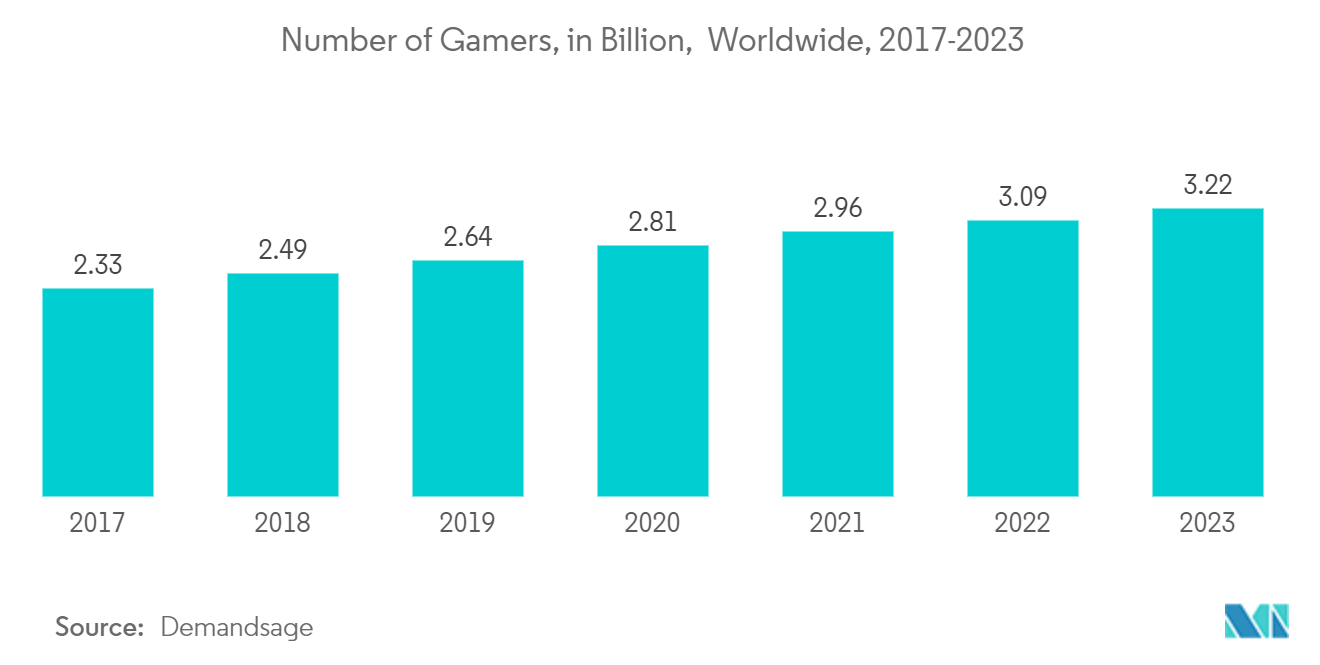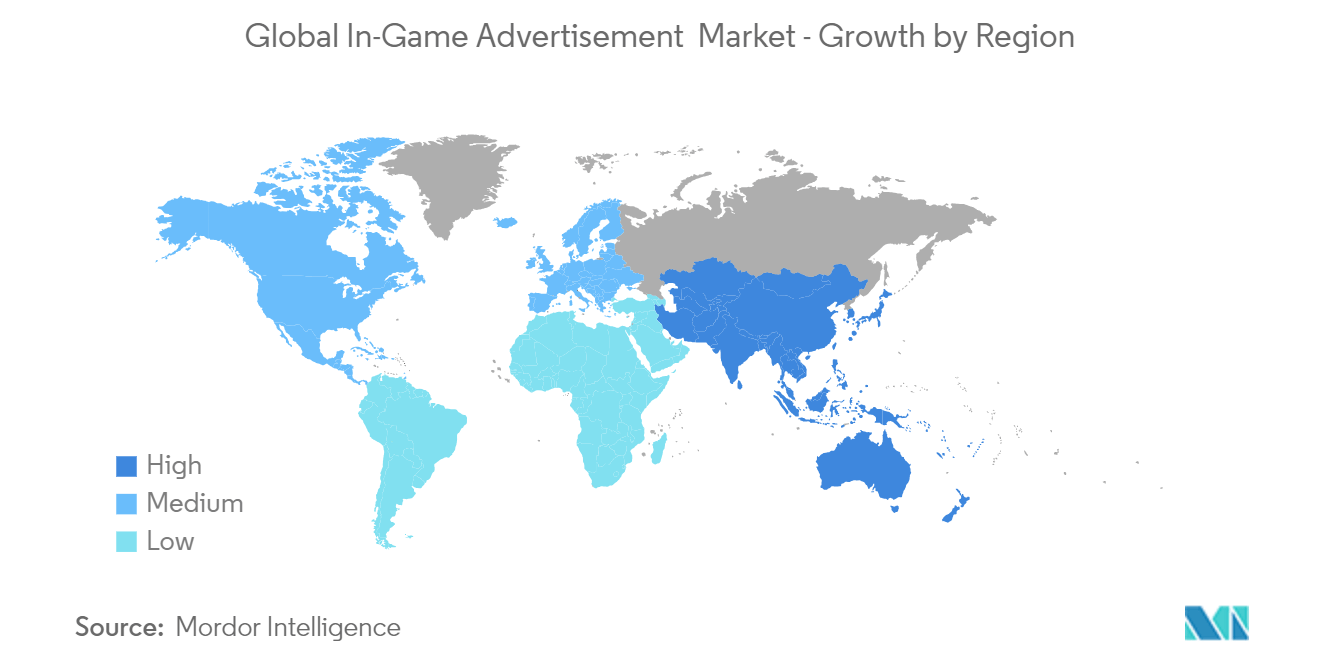Market Trends of In-game Advertising Industry
Increase in Online Gaming is Expected to Drive the Market
- The online gaming market realizes impressive volumes, and the key driver of the market volume can be considered the increased internet penetration and expansion of low-cost mobiles among the urban and rural populations. The monetization is realized through revenue streams, such as in-app purchases per download and subscription services by gamers, in-app advertisements, incentive-based advertisements, etc., by the ecosystem. In the current market scenario, monetization is dominated by publishers and advertisers. In recent years, the internet ecosystem has initiated course correction by end-to-end local game development. For instance, Zynga's shift from social to mobile meant several tough years, but in February 2022, it reported Q4 revenue of USD 727 million, up by 52% year-over-year.
- As per the Game Committee of the Publishers Association of China, In 2022, there were about 654 million mobile gamers in China. The revenue of casual mobile games reached CNY 34 billion (4.68 USD Billion). Such revenue generation from different sources may be due to the rise in the number of gamers, and this would create an opportunity for the in-game advertising players to develop new ads and expand their presence to a vast customer base.
- Smartphones are the most popular gaming device, allowing advertisers to reach casual players who are unlikely to pay for ad-free platforms. Developers can integrate many different online casual game advertising strategies and ad formats into their games to drive mobile game ad income, such as rewarded video ads, offer wall ads, and interstitial ads. The advertisements that perform best and deliver the highest eCPMs (effective cost per 1,000 impressions) are the ones that are incorporated directly into the game loop and complement the in-game economy; in other words, ads that work as a component of the game.
- According to Demandsage, there are 3.220 billion gamers in the world as of 2023. The gaming industry has become one of the most exciting places for new tech innovations. As competition has ramped up, developers and companies have been introducing better hardware and software, with the whole industry moving forward at an increased pace. Due to rapid demographic changes, geography, and consumption in the mobile ecosystem and entertainment landscape, the game space is getting increased attention and investment, both from within the industry, traditional financial markets, and even governments.
- In May 2023, Frameplay, an enabler of in-gaming advertising, and Gamestack, a gaming marketing company, announced a partnership to offer intrinsic in-game advertising solutions in the Indian gaming market, which continues to grow rapidly. This collaboration will allow brands to reach a vast audience of engaged Indian gaming communities through immersive in-game advertisement experiences. The association between Frameplay and Gamestack comes at a critical time when brands are examining to target the Indian gaming audience.

North America is Expected to Hold Significant Share of the Market
- The North American in-game advertising market is anticipated to increase due to the increasing popularity of mobile and console gaming in countries like the U.S. and Canada. The high penetration of mobiles and Internet access has led to a significant increase in mobile gamers. The demand for AAA games with advanced features in gaming consoles is also on the rise, fueled by increased console sales. Additionally, the growing popularity of e-sports and the involvement of sponsors contribute to the market's growth. Overall, the North American in-game advertising market is expected to expand in the forecast period.
- According to a study by the ESA, more than 227 million players across the U.S. region have recently played video games. In total, 80% of the players are over 18 years old. Further, 76% of the American kids who are under 18 years are players. Additionally, 74% of American households have at least one video game player. Also, during the pandemic, 71% of parents agree that video games have been a much-needed break for their children, and 66% agree that video games have made the transition to distance learning more accessible. Such a huge rise in online gamers would allow the studied market to grow.
- Mobile phone gaming is a burgeoning industry in the United States, and one of the largest game publishers is based there. According to 42Matters, out of the 161,440 game publishers on Google Play, more than 8,797 are American companies. Lion Studios, Imangi Studios, Ivy, Play365, i6 Games, DVloper, Oppana Games, Lowtech Studios, Roblox Corporation, and Niantic Inc. are some of the most well-known American publishers. The United States accounts for 5% of all game publishers on Google Play. Such huge mobile gaming would create an opportunity for the studied market to grow in the region.
- Similarly, According to 42mattrers Canadian mobile gaming statistics in 2022, Out of the 430,817 games available on Google Play, more than 6,356 are from Canadian publishers. Real Drive 3D, Tangle Master 3D, Brain Test: Tricky Puzzles, Move People, Bingo Blitz- Bingo Games, PAW Patrol Rescue World, Spider Solitaire, Solitaire, Blush, and Sonic Dash - Endless Running are the mobile games with the most downloads from Canadian publishers. Canadian publishers account for 1% of all mobile games on Google Play. Furthermore, Google Firebase is used in 62% of mobile games published in Canada. There were 3,451 games in total.
- The regional players are raising funds to expand their presence in the region. For instance, In June 2023, in-game ad company Anzu announced a USD 48 million Series B round, bringing its total funding to USD 65 million. The company's immediate plans for reinvesting its new capital include hiring more executive leadership to spearhead sales and partnerships, growing its engineering team, and expanding its presence in the U.S.


